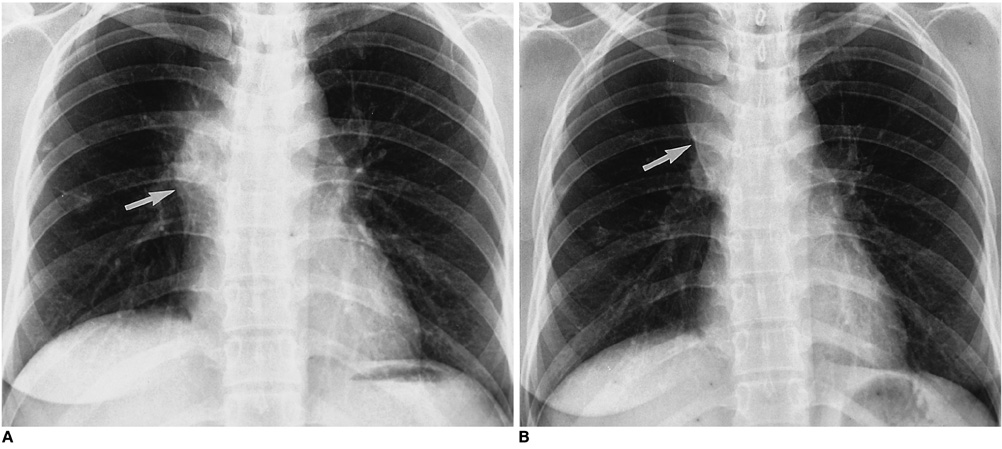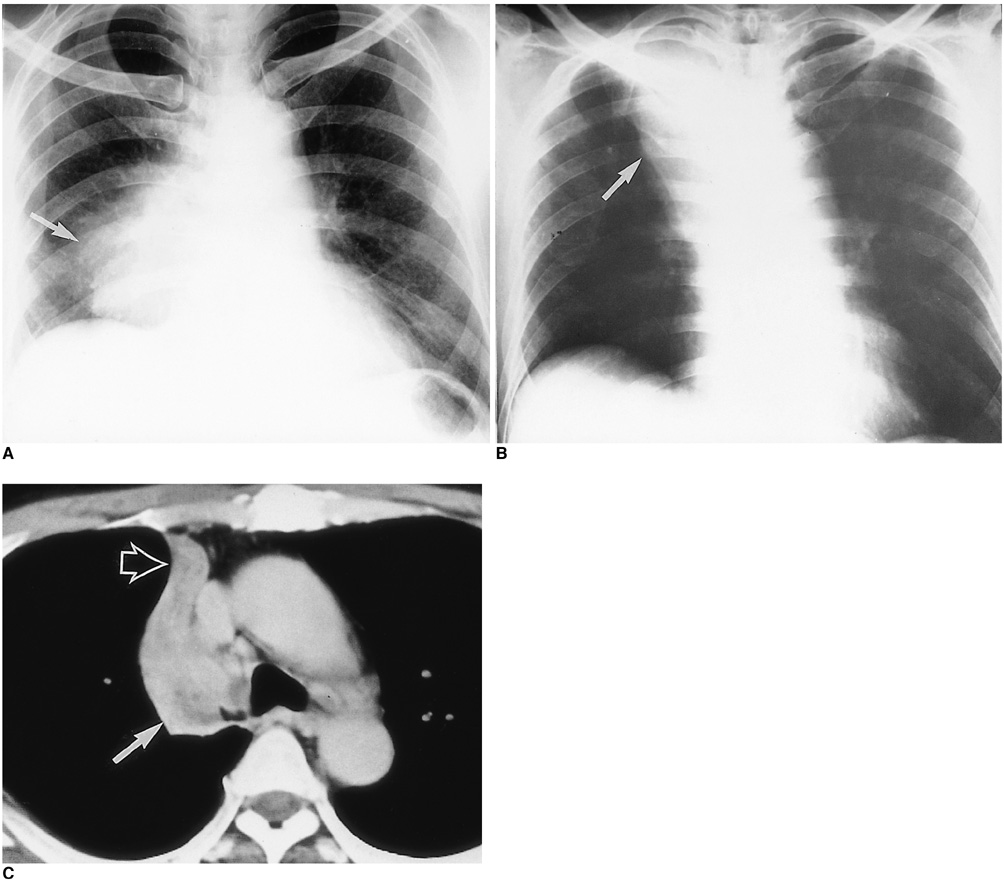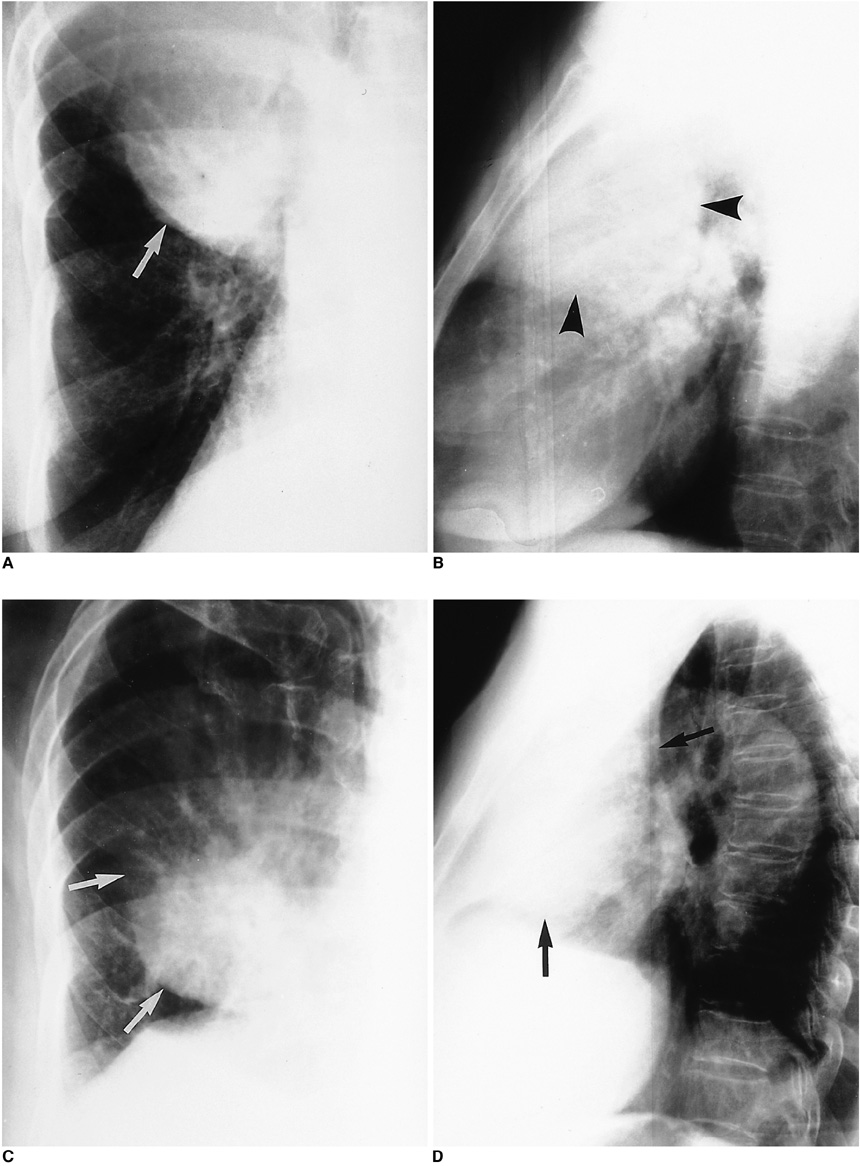Korean J Radiol.
2000 Mar;1(1):33-37. 10.3348/kjr.2000.1.1.33.
Migrating Lobar Atelectasis of the Right Lung: Radiologic Findings in Six Patients
- Affiliations
-
- 1Department of Radiology, Samsung Medical Center, Sungkyunkwan University School of Medicine, Seoul, Korea.
- KMID: 1777293
- DOI: http://doi.org/10.3348/kjr.2000.1.1.33
Abstract
OBJECTIVE
To describe the radiologic findings of migrating lobar atelectasis of the right lung. MATERIALS AND METHODS: Chest radiographs (n = 6) and CT scans (n = 5) of six patients with migrating lobar atelectasis of the right lung were analyzed retrospectively. The underlying diseases associated with lobar atelectasis were bron-chogenic carcinoma (n = 4), bronchial tuberculosis (n = 1), and tracheobronchial amyloidosis (n = 1). RESULTS: Atelectasis involved the right upper lobe (RUL) (n = 3) and both the RUL and right middle lobe (RML) (n = 3). On supine anteroposterior radiographs (n = 5) and on an erect posteroanterior radiograph (n = 1), the atelectatic lobe(s) occupied the right upper lung zone, with a wedge shape abutting onto the right mediastinal border. On erect posteroanterior radiographs (n = 6), the heavy atelectatic lobe(s) migrated downward, forming a perior infrahilar area of increased opacity and obscuring the right cardiac margin. Erect lateral radi-ographs (n = 4) showed inferior shift of the anterosuperiorly located atelectatic lobe(s) to the anteroinferior portion of the hemithorax. CONCLUSION: Atelectatic lobe(s) can move within the hemithorax according to changes in a patient's position. This process involves the RUL or both the RUL and RML.
Keyword
MeSH Terms
Figure
Reference
-
1. Heitzman ER. The lung: Radiologic-pathologic correlation. 1984. 2nd ed. St. Louis: Mosby-Year Book;457–501.2. Lee KS, Logan PM, Primack SL, Muller NL. Combined lobar atelectasis of the right lung: imaging findings. AJR. 1994. 163:43–47.3. Lee KS, Ahn JM, Im J-G, Muller NL. Lobar atelectasis: typical and atypical radiographic and CT findings. Postgrad Radiol. 1995. 15:203–217.4. Felson B. Lung torsion: radiographic findings in nine cases. Radiology. 1987. 162:631–638.5. Graham RJ, Heyd RL, Raval VA, Barrett TF. Lung torsion after percutaneous needle biopsy of lung. AJR. 1992. 159:35–37.6. Meisell R. Case of the spring season: right upper lobe collapse with lobar torsion. Semin Roentgenol. 1980. 15:115–116.7. Huang T-Y, Cho S-R. Torsion of the lung without trauma. Radiology. 1979. 132:25–26.8. Moser ES Jr, Proto AV. Lung torsion: case report and literature review. Radiology. 1987. 162:639–643.9. Berkmen YM, Yankelevitz D, Davis SD, Zanzonico P. Torsion of the upper lobe in pneumothorax. Radiology. 1989. 173:447–449.10. Pinstein ML, Winer-Muram H, Eastridge C, Scott R. Middle lobe torsion following right upper lobectomy. Radiology. 1985. 155:580.11. Munk PL, Vellet AD, Zwirewich C. Torsion of the upper lobe of the lung after surgery: findings on pulmonary angiography. AJR. 1991. 157:471–472.12. Ransdell HT Jr, Ellison RG. Volvulus of a lobe of the lung as a complication of diaphragmatic hernia: a case report. J Thorac Surg. 1953. 25:341–345.
- Full Text Links
- Actions
-
Cited
- CITED
-
- Close
- Share
- Similar articles
-
- Lobar Atelectasis: Typical and Atypical Radiographic and CT Findings
- Lobar Bronchial Rupture with Persistent Atelectasis after Blunt Trauma
- Clinical characteristics and associated factors of Mycoplasma pneumoniae pneumonia with atelectasis in children
- Correlation of plain film and computed tomography findings of lobar atelectasis
- Atelectasis of Right upper Lobe after Left Thoracotomy under General Inhalation Anesthesia




